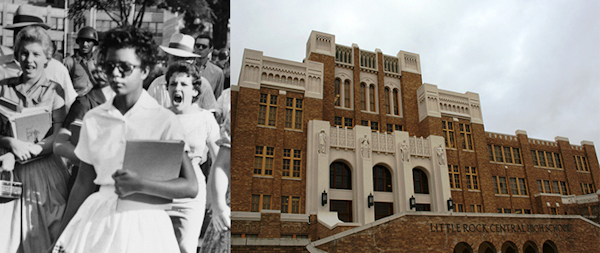Photo illustration by: Will Gentry
As the U.S. remembered the life and work of Martin Luther King Jr. this week, some raised concerns on racial equality in the school systems, claiming that segregation is still in existence in the U.S.
Are inner-city schools really desegregated?
Many schools today tend to have a majority ethnicity or race rather than an even mix. This new form of segregation has caused problems in the classroom and has created gaps in education.
According to “Arkansas Desegregation Payments Stop to Little Rock Schools,” an article from foxnews.com, some of Little Rock, Ark’s., affluent white neighborhoods have better schools. The district’s black students on average have lower grades and test scores and more disciplinary problems than white students.
Assistant Professor of Education Allison Cassady argued the merits of diversity that desegregation adheres to
“I feel like in today’s society, the issue of segregation in any form should be nonexistent,” Cassady said. “Unfortunately there are some that disagree with this point of view. Being in the field of education, we want to encourage teachers not to be colorblind with regards to their student’s gender or race, but instead value each student for their unique life experiences, and for being who they are. I think that desegregation is a positive thing, so that children will understand and appreciate everyone.”
Sophomore and early childhood education major Madison Talley recognizes both the positive and negative implications of desegregation.
“I think that the desegregation in schools is very good for our nation, but recently it has begun to change, and it has many downsides to it,” Talley said.
According to the Fox News article, data from the Arkansas Department of Education that tracked students between their high school years and their first year of college showed that students from the area’s private high schools were better prepared for college and scored higher on the ACT college entrance exam.
“In my experience, all students can learn,” Cassady said. “Their skin color has no factor in their ability. It is our responsibility as teachers to teach the whole child in the way they learn best. Test scores are not a thorough explanation of a child’s ability to learn, and cannot accurately reflect their race or ethnicity.”
In school districts where there tends to be a majority of black students, some white students have chosen to go to nearby private schools instead. For some, it has to do with the attendance of a majority race, or the high or low test scores the school has.
“Typically this just has to do with the zoning of school districts,” Cassady said. “We should teach the child, not the child’s race.”
Talley agreed.
“I think that it has a lot to do with the school district,” Talley said. “Generally the poorer the school and the area that it is in, the lower the test scores, no matter what race. Teaching is also probably an issue, because I could see many teachers turning away from a lower-income school for an opportunity to teach at a higher-income school, where they will have a higher pay and probably less disciplinary problems.”
According to Talley, people tend to live near other people that are like them.
“America is such a mixture of cultures, and people enjoy being with others who share their culture and other values,” Talley said. “Since the school districts are formed based on where you live, it makes sense that a majority of one race is living in the same area and therefore going to the same school. Also money has a part; there are poorer sections of cities where the housing is cheaper and there are richer sections, causing a separation between those who have money and those who don’t.”
Junior Victor Black said that he believes de facto segregation is real and alive, and that’s OK.
“Our cultural distinctions make it natural for us to spend more time with, and live in, the same districts as people who share a like mind,” Black said.
Cassady admitted that desegregation hasn’t had much significance on her, and she wants her students to overcome these issues.
“[We are] trying to constantly encourage the education majors to believe that all children can learn and be successful, and that it is our calling to love them,” Cassady said.
Some have brought up the fact that today’s desegregation in schools is almost causing a re-segregation with the current resources the schools possess, including money, quality education and supplies they need to learn, such as books and computers.
“I think that the segregation that we are facing is just a different type of segregation,” Talley said. “Not that the desegregation efforts of the past are bad, just outdated. In a way, the efforts are probably causing some segregation, so we need to change the way we are dealing with the problems.”
Martin Luther King Jr. recognized that social change is something that should be regularly fought for.
“Change does not roll in on the wheels of inevitability, but comes through continuous struggle,” King said.
School districts are trying to come up with plans to get different races into their schools, instead of just having a majority.
Talley believes that one of the foundations of a good school is good teachers.
“I think schools could start by training their teachers to be the best that they can be,” Talley said. “Also, I think getting parents involved in the kid’s life and schoolwork is very important. Kids, especially the younger ones, seem to do better and learn more when their parents are interested, and encourage them about their schoolwork.”












Be First to Comment